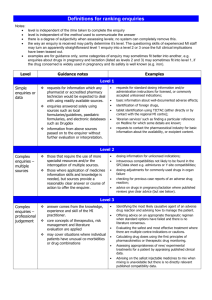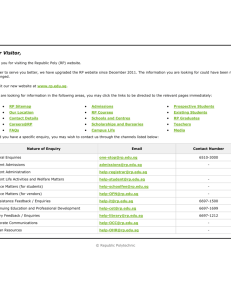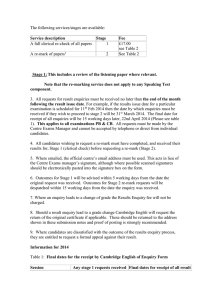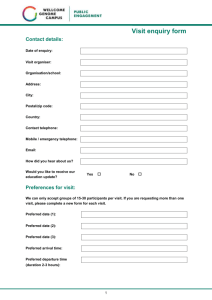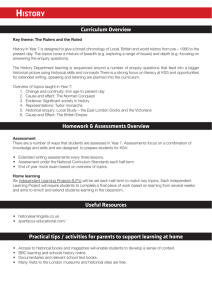Framework to Manage Customer Enquiries for SMEs
advertisement
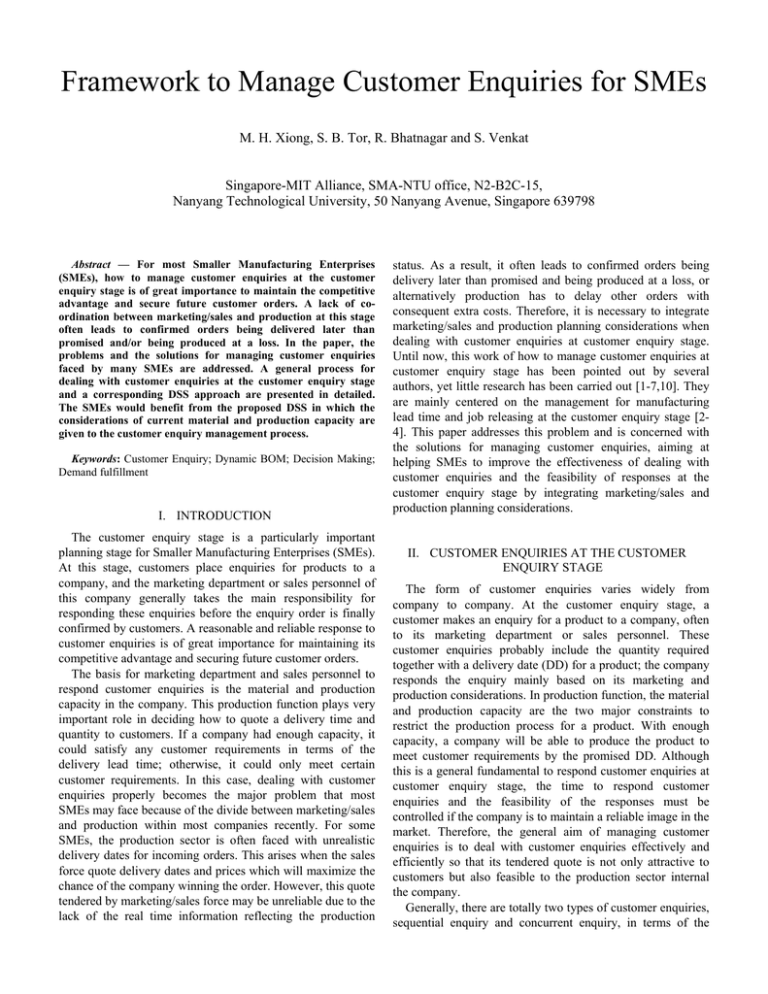
Framework to Manage Customer Enquiries for SMEs M. H. Xiong, S. B. Tor, R. Bhatnagar and S. Venkat Singapore-MIT Alliance, SMA-NTU office, N2-B2C-15, Nanyang Technological University, 50 Nanyang Avenue, Singapore 639798 Abstract — For most Smaller Manufacturing Enterprises (SMEs), how to manage customer enquiries at the customer enquiry stage is of great importance to maintain the competitive advantage and secure future customer orders. A lack of coordination between marketing/sales and production at this stage often leads to confirmed orders being delivered later than promised and/or being produced at a loss. In the paper, the problems and the solutions for managing customer enquiries faced by many SMEs are addressed. A general process for dealing with customer enquiries at the customer enquiry stage and a corresponding DSS approach are presented in detailed. The SMEs would benefit from the proposed DSS in which the considerations of current material and production capacity are given to the customer enquiry management process. Keywords: Customer Enquiry; Dynamic BOM; Decision Making; Demand fulfillment I. INTRODUCTION The customer enquiry stage is a particularly important planning stage for Smaller Manufacturing Enterprises (SMEs). At this stage, customers place enquiries for products to a company, and the marketing department or sales personnel of this company generally takes the main responsibility for responding these enquiries before the enquiry order is finally confirmed by customers. A reasonable and reliable response to customer enquiries is of great importance for maintaining its competitive advantage and securing future customer orders. The basis for marketing department and sales personnel to respond customer enquiries is the material and production capacity in the company. This production function plays very important role in deciding how to quote a delivery time and quantity to customers. If a company had enough capacity, it could satisfy any customer requirements in terms of the delivery lead time; otherwise, it could only meet certain customer requirements. In this case, dealing with customer enquiries properly becomes the major problem that most SMEs may face because of the divide between marketing/sales and production within most companies recently. For some SMEs, the production sector is often faced with unrealistic delivery dates for incoming orders. This arises when the sales force quote delivery dates and prices which will maximize the chance of the company winning the order. However, this quote tendered by marketing/sales force may be unreliable due to the lack of the real time information reflecting the production status. As a result, it often leads to confirmed orders being delivery later than promised and being produced at a loss, or alternatively production has to delay other orders with consequent extra costs. Therefore, it is necessary to integrate marketing/sales and production planning considerations when dealing with customer enquiries at customer enquiry stage. Until now, this work of how to manage customer enquiries at customer enquiry stage has been pointed out by several authors, yet little research has been carried out [1-7,10]. They are mainly centered on the management for manufacturing lead time and job releasing at the customer enquiry stage [24]. This paper addresses this problem and is concerned with the solutions for managing customer enquiries, aiming at helping SMEs to improve the effectiveness of dealing with customer enquiries and the feasibility of responses at the customer enquiry stage by integrating marketing/sales and production planning considerations. II. CUSTOMER ENQUIRIES AT THE CUSTOMER ENQUIRY STAGE The form of customer enquiries varies widely from company to company. At the customer enquiry stage, a customer makes an enquiry for a product to a company, often to its marketing department or sales personnel. These customer enquiries probably include the quantity required together with a delivery date (DD) for a product; the company responds the enquiry mainly based on its marketing and production considerations. In production function, the material and production capacity are the two major constraints to restrict the production process for a product. With enough capacity, a company will be able to produce the product to meet customer requirements by the promised DD. Although this is a general fundamental to respond customer enquiries at customer enquiry stage, the time to respond customer enquiries and the feasibility of the responses must be controlled if the company is to maintain a reliable image in the market. Therefore, the general aim of managing customer enquiries is to deal with customer enquiries effectively and efficiently so that its tendered quote is not only attractive to customers but also feasible to the production sector internal the company. Generally, there are totally two types of customer enquiries, sequential enquiry and concurrent enquiry, in terms of the processing logic for customer enquiries within companies. These two types of customer enquiries are showed in Fig. 1. The sequential enquiries are the customer enquiries that will be considered and processed sequentially. This type of customer enquiry is often referred to the enquiries requested for unusual huge amount of product or with a short delivery time. For these enquiries, it is necessary to make a feasible response because it would lose the opportunity to make a profit or strongly affect the workload balance within a company if the quote is not properly tendered. Sometimes, a company would consider some enquiries altogether at a regular time schedule. This kind of customer enquiries is called the concurrent enquiry because the processing logic of a company needs to consider them concurrently at a specific time point. Usually, the concurrent enquiries must be evaluated and selected to meet under certain objectives such as minimizing inventory cost presented in the paper [7]. The first is the ability to quote competitive lead times for delivery of the product; another is, by given competitive lead times, able to ensure that lead time promises are kept. It is obvious that failing to meet delivery promises has resulted in lost profit and lost market share. On the contrary, keeping the delivery date promises will be helpful to maintain a good image of a company in the market for reliability. III. CUSTOMER ENQUIRY MANAGEMENT FOR SMEs There are a lot of considerations in the treatment of customer enquiries at customer enquiry stage. For example, some considerations for this problem can be summarized and listed as follows, 1) Profit of fulfilling the enquiry order 2) Importance of the customer 3) Value of the order in affecting future business rd nd st st 4) Possibility of repeat business 1 enquiry 3 2 1 5) Contribution to balance the workload for work centers nd enquiry enquiry enquiry Processing Processing 2 enquiry 6) Gain entry into new market sector Logic … Logic 3rd enquiry Of all these considerations, the production sector of … companies mainly takes into account the workload of work (a) Sequential customer enquiries (b) Concurrent customer enquiries centers in workshop as well as the capacity utilization, while the marketing department is concerned more about the chance Fig. 1. Two types of customer enquiries to win enquiry orders. This often results in the unfeasible Each of the customer enquiries made by customers at the delivery date and the production at a loss. Therefore, the customer enquiry stage generally has either fixed delivery date integration between marketing and production is very or flexible delivery date. A customer enquiry with a fixed important for managing customer enquiries at the customer delivery date usually refers to that certain amount of product enquiry stage. will be required by a customer at a specific delivery date, and The customer enquiry management includes a lot of the delivery date required often cannot be changed without research issues. The first important issue is the treatment of negotiating with customers beforehand. For a customer customer enquiries. The treatment of an enquiry is basically a enquiry with flexible delivery date, a feasible delivery date multi-stage decision process. But for SMEs, a sort of must be determined for quoting, approving and negotiating compressed decision-making structure is very helpful because purposes. it can make companies agile to suit the varying customer The feasibility of the tendered quote and the efficiency to needs. In this sort of decision-making structure, the initial deal with enquiries are the two major factors in managing decision is to determine whether or not to accept the enquiry customer enquiries. If the company is to maintain a reliable order based on a prescreening process. Another decision is to image in the market, the time to respond customer enquiries decide how to respond customer enquiries, which generally must be controlled. At the customer enquiry stage, the time includes the decision of rejecting or accepting the enquiry spent in response to a customer enquiry is between the receipt order as well as asking for further negotiation with customers. of the customer enquiry and the completion of the response. It This decision must determine what’s the delivery date for a could be controlled by the marketing department and the sales certain quantity of required product as well as other related force in companies. Some very important enquiries such as issues. For the sake of securing the customer enquiry order, a that with an unusual huge quantity required for a product or SME has the choice of putting a lot of effort to increase the with a very short delivery time, must be considered and production capacity or making an alternative offer for the approved by a sort of authorities, e.g. the tender vetting enquiry expecting further later negotiation with the customer. committee meeting, in the company. As mentioned above, at the customer enquiry stage, the Typically, the customer makes an enquiry to several considerations of production planning have to be given to the possible companies that are able to produce the product the response to customer enquiries because the production customer requires. These companies are thus in a competitive capacity of a company is a major constraint for satisfying situation in determining how to respond to these customer customer requirements. Therefore, the feasibility of being able enquires. If the price issue involved is ignored (it is beyond to produce the enquiry order based on current material and the scope of the paper), the chances of winning the enquiry production capacity at different delivery dates needs to be order will depend upon what values the company gives to the evaluated at this stage. In order to offer a competitive delivery quoted delivery lead time. The delivery lead time is important lead time and then keep this delivery promise, it needs to test for a company to respond customer enquiries in two aspects. the feasibility of the delivery date or the alternative delivery dates, as well as plan the capacities and special actions needed to achieve them. If the customer has specified a delivery date, then the time frame is considered as fixed and the task is to determine whether sufficient capacity is available or can be provided to complete the new enquiry order in addition to other jobs that have already been confirmed for that time period. Although customer enquiries can arise in a variety of ways, the process to respond customer enquiries including abovementioned two-level decision making structure at the customer enquiry stage can be represented in Fig 2. There are several major processes in dealing with customer enquiries as follows. 2) Check DD. A fixed DD included in a customer enquiry is verified about whether it is feasible based on the material and production capacity of the company. 3) Determine DD. If a customer makes an enquiry with a flexible DD, a feasible DD for the customer is determined based on material and production capacity for the customer to consider. 4) Concurrent Enquiry Evaluation. The concurrent enquiries are evaluated and only a part of these enquiries is selected to satisfy if current material and production capacity is not sufficient to meet the whole customer requirements. 5) Determine Alternative DDs. In the case that the DD required by customers is not feasible but the company still CUSTOMER Enquiries Response Pre-screening & Reject Decision Accept enquiries? no Get Approval yes sequential Sequential or concurrent ? Fixed DD Fixed DD or flexible DD flexible DD? Determine DDs Check DD yes DD is feasible? alt. DD Determine Alternative DDs concurrent Evaluate enquiries against Matl avail & Prod capac. Select feasible enquiries to meet no Alt. DD or adj. Cap or No actions? adj. capacity Adjust Capacity No actions taken Response Decision Accept/Reject/Negotiate decision Fig. 2. The generic process for customer enquiry management at the customer enquiry stage 1) Pre-screening and Reject Decision. For some specific customer enquiries such as that with special specifications that are beyond the range of available products produced by the company, a prescreening is carried out and a reject decision is made directly at this process. hopes to secure this customer order, a set of alternative DDs is calculated expecting further later negotiation with the related customer. 6) Adjust Capacity. The action of adjusting capacity which can increase the material and production capacity can be taken by overtiming, rescheduling and reallocating operators. 7) Response Decision. It is to make the decision for responding customer enquiries. It may include the decision of rejecting or accepting a customer enquiry order as well as asking for further negotiations with customers in terms of DD and quantity. 8) Get Approval. For certain customer enquiries such as that with an unusual huge quantity and a very short delivery time, the response decision should be presented to a sort of authorities for approval, e.g. the tender vetting committee meeting, in a company. As discussed above, the production planning considerations have to be taken into account at the time making a response to a customer enquiry. Therefore, the approach to integrate the material availability with production capacity is very important for customer enquiry management at the customer enquiry stage. Several papers written by authors addressed this problem and presented an Extended Dynamic BOM Approach [9-10] to explore multilevel BOM when dealing with manufacturing process from raw materials to finished product. Another important issue for managing customer enquiries is capacity adjustment. Sometimes, because of the importance of the customer or the value of the enquiry order in affecting future business, it may be necessary to take special actions of adjusting material and production capacity to produce the order in less than production’s normal time. These actions, for example, include working overtime, subcontracting or delaying some existing orders. This gives the need for some dynamic production capacity planning module enabling the production planner to try out alternatives in real time to see their effect on manufacturing and delivery lead times. In most cases, there will be a set of feasible DDs, each requiring different capacity levels and assuming a different priority for the enquiry. The cost of achieving each DD in terms of job priority and any capacity adjustments will be indicated in terms of the necessary actions such as work overtime, reallocate operators and split batching. IV. DSS APPROACH FOR MANAGING CUSTOMER ENQUIRIES As described in Section III, there are a lot of considerations in the treatment of customer enquiries at customer enquiry stage. Each of these considerations can be selected for future research. Generally, there are complex relations between one another. Sometimes among these considerations, two considerations may be even contradictive in some cases. For instance, “Profit of fulfilling the enquiry order” may conflict with “importance of the customer” for a specific enquiry. That is to say, an enquiry made by a very important customer may not definitely imply that the company could make a big profit on fulfilling this enquiry order. Therefore, it is very difficult to model this problem mathematically to achieve the optimal goals concurrently for the whole considerations. At this moment, a suitable and feasible approach to handle such sort of problems is to provide a list of measures to aid users to make the right decisions rather than produce some “optimal” solutions. For customer enquiry management, when dealing with customer enquiries, the marketing department or sales personnel make their decisions under an DSS environment which provides with all related information such as information of customers, capacity for work centers and material availabilities, as well as some measures to assess the alternatives. In this way, while DSS proposed provide the necessary information and measures to assess possible decisions made by decision-makers, the decision makers are responsible for making and approving the final decision. This is believed to be a reasonable approach for dealing with customer enquiries at customer enquiry stage. For enquiries made by very important customers or that with unusual large quantity or very short delivery time, it is envisaged that the proposed DSS will be used either interactively at the tender vetting committee meeting, which makes the final decision on responding to and approving this category of customer enquiries, or in the preparation for such a meeting. For enquiries that are considered not important enough to hold a committee meeting, it is anticipated that it would be used by the person responsible for responding to the enquiry. This person is usually within the marketing department. In either case, the proposed DSS should allow the users to examine the implications of alternative courses of action in real time. The DSS approach for managing customer enquiries for SMEs should reflect the processing requirements proposed in Fig. 2. The ways the various elements proposed in Section III would fit into this integrated system for dealing with the two major types of enquiries, sequential and concurrent enquiry. The general architecture of this DSS approach for managing customer enquiries for SMEs is proposed and illustrated in Fig. 3. The aim of the proposed DSS approach is to help the marketing department and sales force respond customer enquiries properly and effectively by means of providing the decision-makers with various feasible solutions and necessary information. This DSS can be envisaged as a front-end module to deal with the customer enquiries before customer orders are confirmed and involved in next production planning process. Generally, there are following two parallel parts of research are involved in the proposed architecture. 1) The methodology for managing customer enquiries at the customer enquiry stage for SMEs; and 2) Development issue relating with the proposed DSS approach. The methodology for managing customer enquiries refers to a set of methods to deal with the problem, including the general processing procedure, approaches as well as supporting tools. Because dealing with the sequential enquiries and the concurrent enquiries are the two major factors involved, the corresponding approaches are needed to further developed. Paper [7] presents a concept model for dealing with concurrent enquiries. Related researches are being undertaken at present. The methodology is the basis for developing the DSS to manage customer enquiries. CUSTOMER Accept/ Reject/ Negotiate Enquiries INTERFACE Pre-screen Check DD Determine DD Enquiry Evaluation Make response decision Get Approval Enquiry DB Customer DB Capacity DB Material DB Fig. 3. General DSS architecture for managing customer enquiry for SMEs In the proposed system architecture showed in Fig. 3, associated with the major processes to respond to customer enquiries at the customer enquiry stage, there are several main modules that sequentially carry out the tasks of generating the response. 1) Check DD module. The module is to check whether or not a requested DD is feasible based on the material and production capacity. If not, then it is assumed that some capacity adjustments will be, if necessary, selected and indicated in terms of the necessary actions such as work overtime, reallocate operators and rescheduling. 2) Determine DD module. This module which generates a feasible DD or a set of alternative DDs uses production routings and available material and production capacity to assess if and when the enquiry order can be fitted into the workload of the company. For a customer enquiry without stating a fixed DD, a set of feasible DDs is determined by this module; for a customer enquiry with a fixed DD, the feasibility to accept this enquiry order based on the material and production capacity must be assured. The output of the module can help to tender a quote for a customer enquiry and further negotiate with the customer. 3) Enquiry evaluation module. The concurrent enquiries is dealt with by the module by achieving such objectives as reducing the inventory cost and increasing the possible profit. The DSS should provide several objectives to facilitate the requirements of different users. Hence, some mathematical model might be combined with judgmental rules to improve the accuracy of the evaluation process. 4) Response decision making module. Within this module, the decision makers are presented with a set of feasible alternative responses to enquiries in an interactive manner. This module does not attempt to determine the optimal solution; rather it presents information and necessary assessing tools for the decision makers to make an informed choice for customer enquiries. The output of this module will be a decision regarding whether to accept an enquiry order and if so the delivery date to quote for an enquiry with a flexible DD, as well as the decision about further negotiating with customers about the quantity and DD that can be promised by the company if this customer enquiry is considered very important. From the information provided, the decision makers can investigate each of the options further if required. For example, the detailed impact a DD would have on the workload can be examined graphically, and the decision about alternative ways of adjusting the capacity whilst attaining the same DD could be made by decision makers. Besides, there is a module of decision approval in the system architecture. It is to get approval from authorities of companies for some very important customer enquiries and unusual customer enquiries. The later, for example, refers to a customer enquiry with an unusual huge quantity for a product or a very short delivery time. These customer enquiry orders would strongly influence the following production planning and scheduling; hence the responses for these enquiries must be gotten approved before tendering quotes to customers. To develop the proposed DSS prototype is another important research issue. It includes the design and implementation for the platform to build the DSS, the database to support the system and approaches proposed as well as the integration of the whole systems. Besides, the implementation in a chosen company is also very helpful to assess the proposed methodology for managing customer enquiries at customer enquiry stage for SMEs. The nature of the link between the proposed DSS and other production planning functions will depend on the other systems that a company has in place. Generally, the DSS proposed herein would be used at the front end to carry out the demand planning and generate the master production schedule. Moreover, the output of the DSS can be a piece of helpful information for the capacity planning and the material requirement planning. V. CONCLUSION The process of dealing with customer enquiries so as to attract a sufficient load of profitable work in a highly competitive market is the essential problems faced by many SMEs. Therefore, the customer enquiry management is a very important activity for SMEs. On the other hand, it is also a complex one because of the complexity of its concerns and the gap between the marketing/sales and production considerations. Failing to meet delivery promises would not only result in lost profit and lost market share, but also strongly affect future orders from customers. This paper has described the problems faced by the marketing department and sales force in SMEs when they make responses to customer enquiries at customer enquiry stage. The basic aim is to use the DSS approach to enable the SMEs to make more effective and feasible responses. The general process to deal with customer enquiries at customer enquiry stage and the DSS architecture of customer enquiry management are investigated and presented in the paper. The design and development of the prototype DSS in which the proposed methodology is implemented has been undertaking. REFERENCES [1] B. Kingsman, W. Lee, H. Linda, M. Alan, and W. Elaine, “Integrating marketing and production planning in maketo-order companies”, Int. J. Production Economics, vol.30-31, pp.53-66, 1993. [2] B. G. Kingsman, I. P. Tatsiopoulos, and L. C. Hendry, “A structure methodology for managing manufacturing lead times in make-to-order companies”, European J. of Operational Research, vol.40, no.1, pp.196-209, 1989. [3] L. C. Hendry, and B. G. Kingsman, “Job release: part of a hierarchical system to manage manufacturing lead times in make-to-order companies”, J. Operational Research, vol.42, no.10, pp.871-883, 1991. [4] L. Hendry, and B. Kingsman, “A decision support system for job release in make-to-order companies”, Int. J. of Operations and Production Management, vol.11, no.6, pp.6-16, 1991. [5] L. Hendry, and B. Kingsman, “Customer enquiry management: part of a hierarchical system to control lead times in make-to-order companies”, J. of Operational Research, vol.44, no.1, pp.61-70, 1993. [6] L. C. Hendry, “COPP: a decision support system for managing customer enquiries”, Int. J. of Operations and Production Management, vol.12, no.11, pp.53-64, 1992. [7] M. H. Xiong, S. B. Tor, L. P. Khoo, and R. Bhatnagar, “Fulfillment of rush customer orders under limited capacity”, SMA Symposium 2002, 2002. [8] M. H. Xiong, S. B. Tor, L. P. Khoo and Ch-H. Chen, A Web-enhanced Dynamic BOM-based Available-ToPromise System, forthcoming in Int. J. of Production Economics. 2001. [9] M. H. Xiong, S. B. Tor, R. Bhatnagar, L. P. Khoo and S. Venkat, Extended Dynamic BOM: a New Approach for Handling Multilevel BOM, Working paper, 2002. [10] M. H. Xiong, S. B. Tor, R. Bhatnagar, L. P. Khoo and S. Venkat, Internet based DSS to manage customer enquiries in small and medium-sized make-to-order companies, Working paper, 2002.
